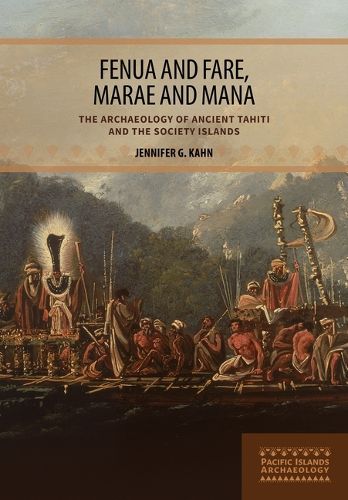Readings Newsletter
Become a Readings Member to make your shopping experience even easier.
Sign in or sign up for free!
You’re not far away from qualifying for FREE standard shipping within Australia
You’ve qualified for FREE standard shipping within Australia
The cart is loading…






In 1767 the shores of Tahiti first appeared in the sights of Captain Samuel Wallis, and ever since, this tropical locale has captured the imagination of explorers, merchants, missionaries, historians, anthropologists, archaeologists, and others. Fenua and Fare, Marae and Mana brings readers back to the time before European contact, starting with the settlement of the archipelago by Polynesian voyagers, or the Ma'ohi, some 1,000 years ago. From the massive stone ruins of chiefly households, agricultural terraces, and religious temples (marae) to sacred foods, clothing, and war cults, Jennifer G. Kahn delves into every aspect of Ma'ohi life.
Drawing on current anthropological and archaeological research, and data from her own field research and that of others, Kahn explores the development of Ma'ohi politics, economies, religion, and social relationships, and their connections to the local environment. Anthropologists and archaeologists have previously investigated how ecology and natural resources, demographic growth, and cultural factors such as status rivalry, religion, and ideology spurred sociopolitical changes in the Society Islands. But how did Ma'ohi settlements coalesce into the powerful chiefdoms encountered by Captain Cook in the late 1700s? Synthesizing a vast amount of archaeological data, oral histories, and historical accounts, Kahn traces changes in Ma'ohi material culture, land use, diet, subsistence, agriculture, settlement patterns, environment, and residential and ritual architecture to present the first authoritative cultural sequence for the pre-contact Society Islands. She also addresses a long-standing debate in historical anthropology by arguing that Ma'ohi society had multiple tiers of chiefs and settlement hierarchies prior to European contact, thus forming a complex chiefdom. Integrating anthropology, archaeology, indigenous history, and theory, Kahn lays out a new model for interpreting complex chiefdoms that blends bottom-up and top-down perspectives on social change.
With special attention to inequality and environmental change, Fenua and Fare uses collective action theory to develop a more nuanced political history of social change, offering fresh insight on the lives and interactions of commoners, land managers, high chiefs, and secondary chiefs. Readers will come away with a new appreciation for how social inequality blooms and grows, not just in the Society Islands, but elsewhere in Polynesia and beyond.
$9.00 standard shipping within Australia
FREE standard shipping within Australia for orders over $100.00
Express & International shipping calculated at checkout
In 1767 the shores of Tahiti first appeared in the sights of Captain Samuel Wallis, and ever since, this tropical locale has captured the imagination of explorers, merchants, missionaries, historians, anthropologists, archaeologists, and others. Fenua and Fare, Marae and Mana brings readers back to the time before European contact, starting with the settlement of the archipelago by Polynesian voyagers, or the Ma'ohi, some 1,000 years ago. From the massive stone ruins of chiefly households, agricultural terraces, and religious temples (marae) to sacred foods, clothing, and war cults, Jennifer G. Kahn delves into every aspect of Ma'ohi life.
Drawing on current anthropological and archaeological research, and data from her own field research and that of others, Kahn explores the development of Ma'ohi politics, economies, religion, and social relationships, and their connections to the local environment. Anthropologists and archaeologists have previously investigated how ecology and natural resources, demographic growth, and cultural factors such as status rivalry, religion, and ideology spurred sociopolitical changes in the Society Islands. But how did Ma'ohi settlements coalesce into the powerful chiefdoms encountered by Captain Cook in the late 1700s? Synthesizing a vast amount of archaeological data, oral histories, and historical accounts, Kahn traces changes in Ma'ohi material culture, land use, diet, subsistence, agriculture, settlement patterns, environment, and residential and ritual architecture to present the first authoritative cultural sequence for the pre-contact Society Islands. She also addresses a long-standing debate in historical anthropology by arguing that Ma'ohi society had multiple tiers of chiefs and settlement hierarchies prior to European contact, thus forming a complex chiefdom. Integrating anthropology, archaeology, indigenous history, and theory, Kahn lays out a new model for interpreting complex chiefdoms that blends bottom-up and top-down perspectives on social change.
With special attention to inequality and environmental change, Fenua and Fare uses collective action theory to develop a more nuanced political history of social change, offering fresh insight on the lives and interactions of commoners, land managers, high chiefs, and secondary chiefs. Readers will come away with a new appreciation for how social inequality blooms and grows, not just in the Society Islands, but elsewhere in Polynesia and beyond.